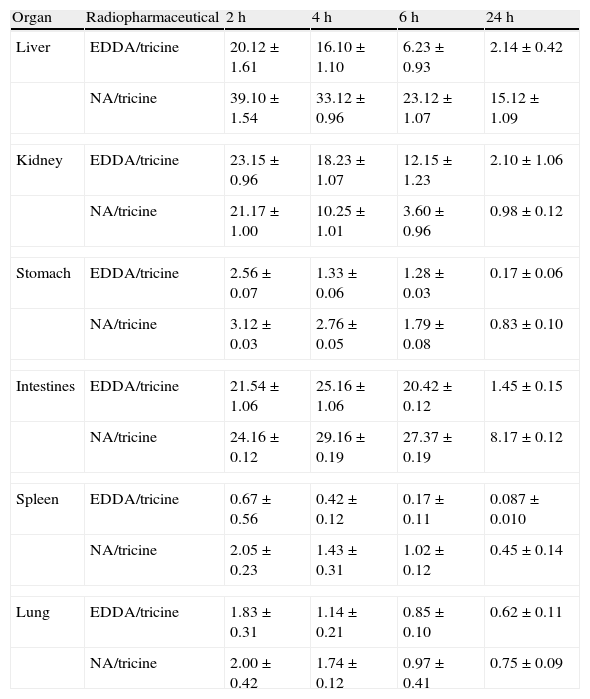The aim of present investigation was to evaluate the biodistribution in healthy animals and in tumor models of the radiopharmaceuticals 99mTc-EDDA/tricine-HYNIC-Lys3-bombesin (HYNIC-Lys3-BN) and 99mTc-NA/tricine-HYNIC-Lys3-BN. Biodistribution and pharmacokinetics were carried out over 24h. To do so, 24 healthy Wistar rats were used and were administered 37.0±0.8MBq/rat of each radiopharmaceutical. For the tumor model study, 20 CD-1 nude mice were used and prostate tumors (PC3) were implanted in all the mice. Ten days later, tumor volumes were calculated and 40.00±0.04MBq/mice of each radiopharmaceutical were injected. Both showed high radiochemical purity: 98.08±0.25% for EDDA/tricine product and 95.1±0.3% for the conjugate with NA/tricine. Uptake of the radiopharmaceutical with NA/tricine was significantly higher in organs of the reticulo-endothelial system of healthy Wistar rats during 24h, specifically in the liver and spleen. Both labeled compounds showed no significant differences between their blood elimination half lives. Average of tumor growth was 0.93±0.02cm3 and affinity for tumors showed a growing and specific binding of both radiopharmaceuticals, although it was significantly higher for the EDDA/tricine conjugate. This outcome made it possible to corroborate the direct relationship between the density of gastrin releasing peptide and its receptors (GRPr) and the variation of the accumulation of the radiopharmaceuticals in the tumor. Use of EDDA/tricine as coligand is more appropriate than NA/tricine for labeling of HYNIC-Lys3-BN with 99mTc.
El propósito de la presente investigación fue evaluar la biodistribución en animales sanos y en modelos de tumores de los radiofármacos 99mTc-EDDA/tricina-HYNIC-Lys3-bombesina (HYNIC-Lys3-BN) y 99mTc-AN/tricina-HYNIC-Lys3-BN. La biodistribución y la farmacocinética fueron realizados durante 24 horas para lo cual se utilizaron 24 ratas wistar sanas a las cuales se les administró 37,0±0,8MBq/rata de cada radiofármaco y para el estudio de modelo de tumor fueron utilizados 20 ratones desnudos CD-1 a los que se les injertaron tumores de próstata (PC3). Diez días después fueron calculados los volúmenes tumorales y aplicados 40,00±0,04MBq/ratón de cada radiofármaco. Ambos mostraron alta pureza radioquímica con valores de 98,08±0,25% para el compuesto con EDDA/tricina y de 95,1±0,3% para el conjugado con AN/tricina. La captación del radiofármaco con AN/tricina fue significativamente mayor en órganos del sistema retículo endotelial de ratas Wistar sanas durante 24h, específicamente en hígado y bazo. No se encontraron diferencias significativas entre los tiempos medios de eliminación de la sangre para ambos compuestos. El volumen promedio de crecimiento tumoral fue 0,93±0,02cm3 y la afinidad por tumores mostró una unión creciente y específica de ambos radiofármacos, siendo significativamente mayor para el conjugado con EDDA/tricina. Este resultado permitió corroborar la relación directa que existe entre la densidad de receptores del péptido liberador de la gastrina (PLGr) y la variación de la acumulación de los radiofármacos en el tumor. El uso de EDDA/tricina como coligando para marcar HYNIC-Lys3-BN con 99mTc, es más apropiado que AN/tricina.
Artículo

Revista Española de Medicina Nuclear e Imagen Molecular (English Edition)
Comprando el artículo el PDF del mismo podrá ser descargado
Precio 19,34 €
Comprar ahora









